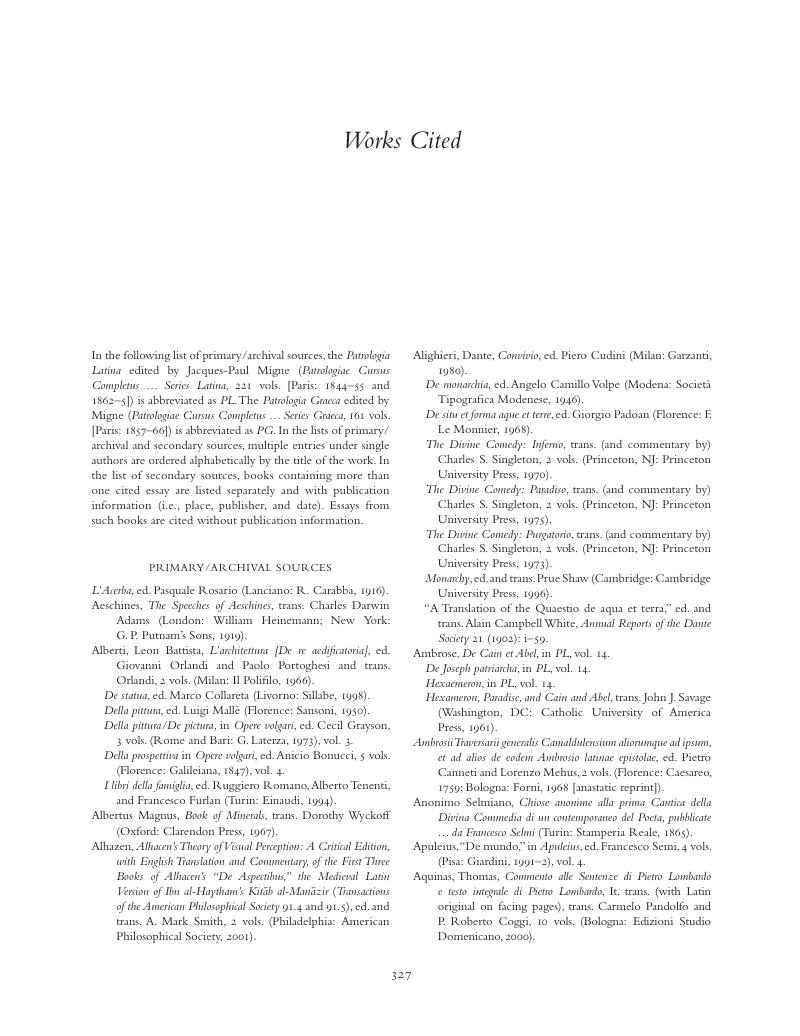 Lorenzo Ghiberti's Gates of Paradise
Lorenzo Ghiberti's Gates of Paradise Book contents
- Lorenzo Ghiberti’sGates of Paradise
- Lorenzo Ghiberti’sGates of Paradise
- Copyright page
- Dedication
- Contents
- Plates
- Figures
- Book part
- Introduction
- Chapter 1 TheAdam and EvePanel: The Birth of Creativity
- Chapter 2 TheCain and AbelPanel: Fashioning Thought and Fate
- Chapter 3 TheNoahPanel: Architecture and Politics Emerge
- Chapter 4 TheAbraham and IsaacPanel: The Sacrifice from the Competition to theGates of Paradise
- Chapter 5 TheJacob and EsauPanel: Perspective, Vision, and Memory
- Chapter 6 TheJosephPanel: Speech Acts in the Piazza
- Chapter 7 TheMosesPanel: Sculpting the Drama of Nature
- Chapter 8 TheJoshuaPanel: The Fate of Art
- Chapter 9 TheDavidPanel: Ghiberti, Tragedian
- Chapter 10 TheSolomon and Queen of ShebaPanel: A Portrait of Ghiberti’s Florence
- Notes
- Works Cited
- Index
- References
Works Cited
Published online by Cambridge University Press: 18 December 2015
- Lorenzo Ghiberti’sGates of Paradise
- Lorenzo Ghiberti’sGates of Paradise
- Copyright page
- Dedication
- Contents
- Plates
- Figures
- Book part
- Introduction
- Chapter 1 TheAdam and EvePanel: The Birth of Creativity
- Chapter 2 TheCain and AbelPanel: Fashioning Thought and Fate
- Chapter 3 TheNoahPanel: Architecture and Politics Emerge
- Chapter 4 TheAbraham and IsaacPanel: The Sacrifice from the Competition to theGates of Paradise
- Chapter 5 TheJacob and EsauPanel: Perspective, Vision, and Memory
- Chapter 6 TheJosephPanel: Speech Acts in the Piazza
- Chapter 7 TheMosesPanel: Sculpting the Drama of Nature
- Chapter 8 TheJoshuaPanel: The Fate of Art
- Chapter 9 TheDavidPanel: Ghiberti, Tragedian
- Chapter 10 TheSolomon and Queen of ShebaPanel: A Portrait of Ghiberti’s Florence
- Notes
- Works Cited
- Index
- References
Summary

- Type
- Chapter
- Information
- Lorenzo Ghiberti's Gates of ParadiseHumanism, History, and Artistic Philosophy in the Italian Renaissance, pp. 327 - 348Publisher: Cambridge University PressPrint publication year: 2016


